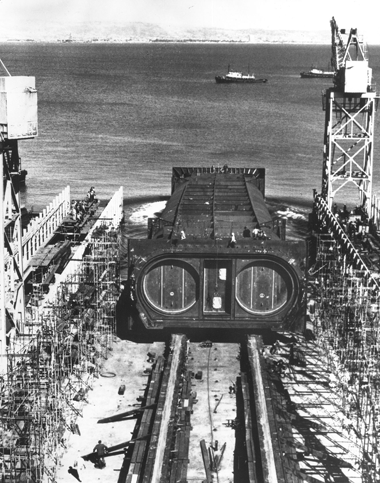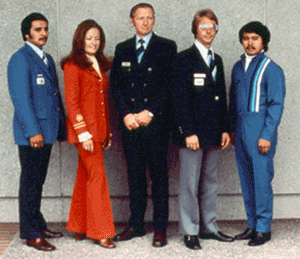
Previously:
The Concept is Born
BART construction officially began on June 19, 1964, with President Lyndon Johnson presiding over the ground-breaking ceremonies for the 4.4-mile Diablo Test Track between Concord and Walnut Creek in Contra Costa County. The test track, completed ten months later, was used to develop and evaluate sophisticated new design concepts for BART's transit car and automatic train control system.
In charge of construction management, overall design of system facilities, equipment and monitoring of BART's major contractors, were the District's General Engineering consultants, Parsons-Brinkerhoff-Tudor-Bechtel, or most commonly known as "PB-T-B"; a joint venture enterprise formed to manage all technical, as well as construction aspects of the BART project. PB-T-B was comprised of three well known engineering consultant firms: Parsons-Brinckerhoff-Quade & Douglas, of New York (who had done the original BART transportation plan); Tudor Engineering Company, of San Francisco; and Bechtel Corporation, of San Francisco.
Through this joint venture, the firms supplied (or recruited from the U.S. and abroad) the most impressive array of engineering talent ever assembled for a single public works project. The basis of the joint venture concept was that engineering specialists could be supplied as needed, moving on to other projects when their respective BART assignments were completed. This was considered less costly and more permanent than building up a large District staff.
Construction began on the Oakland subway in January, 1966. November of that year saw the first of 57 giant steel and concrete sections of the 3.8-mile transbay tube lowered to the bottom of the Bay by a small navy of construction barges and boats.
The 3.2-mile bore through the hard rock of the Berkeley Hills was completed in February, 1967, after 466 work days, to become the fourth longest vehicular tunnel in the U.S.
The first major equipment contract was awarded in May 1967 for the nation's first fully automatic train control system. Westinghouse Electric Corporation's low bid of $26.1 million was $3 million under the next bidder. Four other bidders were General Railway Signal Company, Philco-Ford Company, General Electric Company, and Westinghouse Air Brake Company. Although awarding of the contract to any company other than the low bidder would have been illegal, District officials were destined to face criticism and controversy as a result.
In July, 1967, work began on the Market Street subway and stations 80-100 feet below heavy downtown traffic. Against the combined pressure of mud and bay water, the work required one of the greatest concentrations of tunneling crews and equipment in construction history. Construction of the giant five-story-high stations beneath Market Street and the tunnels themselves, was accomplished under extremely difficult conditions imposed by the high water table in downtown San Francisco, plus an incredible maze of underground utilities installed over the last 100 years. The first tunneling in the western U.S. done entirely under compressed air conditions, the project produced a succession of "firsts" in constructing the subway and stations in a difficult mud and water environment.
Subway excavations were rich with buried ships and other memorabilia, providing a fascinating look back into nineteenth century San Francisco when the land-fill of lower Market Street and the Embarcadero was still open harbor. The huge construction effort reached its peak in 1969 with a contractor force of 5,000 working on the San Francisco subway and other parts of the system, the weekly payroll was more than $1 million.
The final tunnel bore was "holed through" into the west end of the Montgomery Street Station on January 27, 1971. It marked the completion of tunneling work in the huge, two-level Market Street subway and climaxed six years of tunneling underground.
Tunneling under compressed air required a special medical center with equipment specialists for close monitoring of the "sandhog" construction force. Despite the complex problems of sandhogging, the BART project was completed with one of the best safety records in heavy construction.

Engineering History was Made
The contract for the production and delivery of BART's revolutionary electric transit cars was signed with Rohr Industries, Inc., of Chula Vista, California, in July, 1969. The initial contract called for delivery of 250 cars, with the first 10 vehicles to serve as test prototypes.
Meanwhile, a truly great chapter was written in the history of civil engineering with the completion of the transbay tube structure in August, 1969. Constructed in 57 sections, and reposing on the bay floor as deep as 135 feet beneath the surface, the remarkable $180 million structure took six years of toil and seismic studies to design, and less than three years to contract. Before it was closed to visitors for installation of tracks and electrification, many thousands of adventurous people had walked, jogged, and bicycled through the tube. It received a dozen major engineering awards and rapidly became famous, seeming to capture the imagination of visitors from all over the world. To youngsters, especially, the transbay tube is BART.
Unhappily, the major years of BART construction in the 1960's saw seven percent average annual inflation - more than double the rate anticipated by economists and allowed for in the project cost estimates. In this climate, before substantial federal grants were available, BART's financial history was inevitably a troubled one.
While delays and inflation were sapping capital reserves, pressures from public and governmental groups resulted in the relocation of 15 miles of right-of-way and 15 stations, as well as a general upgrading of station plans. Stations were also substantially altered during construction to include elevators and other facilities for seniors and the disabled at an added cost of $10 million. The cost of the transbay tube rose to $180 million from an original estimate of $133 million.
Prime examples of how public pressures escalated the cost of the system are the Berkeley subway and the Ashby Station. After originally approving a combination aerial and subway line through Berkeley, that city later came to oppose the plan in favor of a subway-only line, which was much more expensive. The new plan necessitated redesign of the Ashby Station from an aerial to a subway facility. Extensive controversy and hearings ensued for the next 2 1/2 years, finally to be resolved by Berkeley residents voting to tax themselves additionally to finance the changes they wanted. Next, a Berkeley City Councilman filed a successful suit to redesign the Ashby Station, yet a second time, asserting the use of skylights in the original plans was not a true subway design.
The Berkeley situation resulted in a 2 1/2 year delay in subway construction, a 17-month delay in starting Ashby Station construction, and additional costs of $18 million.
As early as 1966, it became increasingly clear that the District would fall short of funds to complete the system. The only apparent solutions were an infusion of more funds, or a drastic scaling-down of system miles to fit the original budget. Major construction contracts were rewritten and re-advertised in anticipation of the threatened cutbacks.
As the crisis deepened, BART directors refused to compromise the planned 71.5 mile system until every possible alternative could be explored. Finally, in April, 1969, after three years of debate, the State Legislature granted the District's request for $150 million of authorizing the levying of a half-cent sales tax in the BART counties. The needed funds thus came from the sales of bonds pledged against the sales tax revenues.
Next: The Project is Rescued